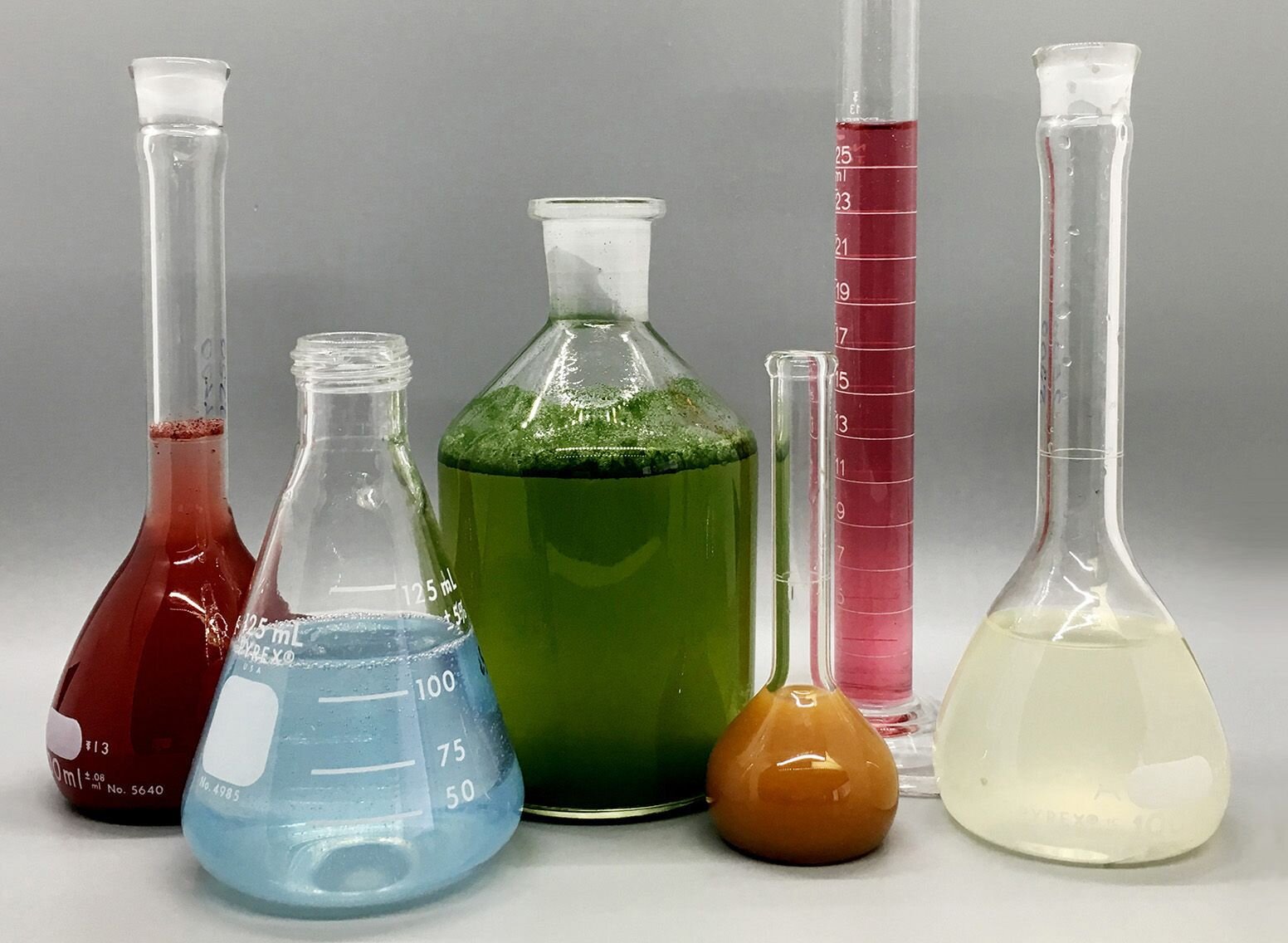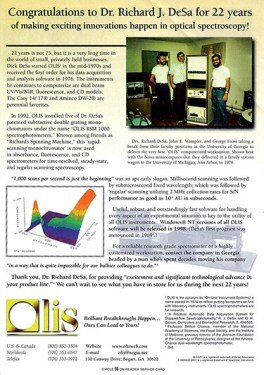Facts About Uv/vis/nir Uncovered
Table of ContentsSome Known Questions About Uv/vis.The smart Trick of Circular Dichroism That Nobody is Talking AboutThe smart Trick of Circularly Polarized Luminescence That Nobody is Talking AboutSpectrophotometers - QuestionsNot known Factual Statements About Circular Dichroism Indicators on Spectrophotometers You Need To KnowThe Greatest Guide To Uv/visA Biased View of Uv/vis/nirExcitement About Uv/vis/nirWhat Does Spectrophotometers Mean?Not known Details About Uv/vis Circular Dichroism for BeginnersThe 10-Minute Rule for Circular Dichroism
It is then scanned through the sample and the reference options. Fractions of the event wavelengths are transmitted through, or shown from, the sample and the recommendation. Electronic circuits convert the relative currents into direct transmission portions and/or absorbance/concentration values.The transmission of a reference substance is set as a standard (datum) worth, so the transmission of all other substances are recorded relative to the initial "zeroed" compound. The spectrophotometer then converts the transmission ratio into 'absorbency', the concentration of particular elements of the test sample relative to the initial compound.
Given that samples in these applications are not easily offered in large amounts, they are particularly suited to being evaluated in this non-destructive technique. In addition, valuable sample can be saved by using a micro-volume platform where as little as 1u, L of sample is required for complete analyses. A brief description of the procedure of spectrophotometry includes comparing the absorbency of a blank sample that does not consist of a colored compound to a sample which contains a colored compound.
Uv/vis Can Be Fun For Anyone
In biochemical experiments, a chemical and/or physical residential or commercial property is selected and the procedure that is utilized is particular to that residential or commercial property in order to derive more details about the sample, such as the quantity, pureness, enzyme activity, and so on. Spectrophotometry can be used for a number of methods such as figuring out optimum wavelength absorbance of samples, identifying ideal p, H for absorbance of samples, figuring out concentrations of unknown samples, and determining the p, Ka of numerous samples.: 21119 Spectrophotometry is also a helpful process for protein purification and can likewise be used as an approach to produce optical assays of a compound.
It is possible to understand the concentrations of a two part mix using the absorption spectra of the basic solutions of each part. To do this, it is required to understand the termination coefficient of this mixture at 2 wave lengths and the termination coefficients of services that contain the known weights of the 2 parts.

The 6-Minute Rule for Circularly Polarized Luminescence
Area. The concentration of a protein can be estimated by determining the OD at 280 nm due to the existence of tryptophan, tyrosine and phenylalanine.
Nucleic acid contamination can also interfere. This method needs a spectrophotometer efficient in determining in the UV region with quartz cuvettes.: 135 Ultraviolet-visible (UV-vis) spectroscopy involves energy levels that excite electronic shifts. Absorption of UV-vis light excites molecules that are in ground-states to their excited-states. Visible area 400700 nm spectrophotometry is utilized extensively in colorimetry science.
20. 8 O.D. Ink makers, printing business, textiles vendors, and much more, need the data offered through colorimetry. They take readings in the region of every 520 nanometers along the noticeable area, and produce a spectral reflectance curve or an information stream for alternative presentations. These curves can be utilized to check a brand-new batch of colorant to check if it makes a match to specs, e.
More About Spectrophotometers
Traditional noticeable area spectrophotometers can not detect if a colorant or the base material has fluorescence. This can make it hard to handle color concerns if for example one or more of the printing inks is fluorescent. Where a colorant includes fluorescence, a bi-spectral fluorescent spectrophotometer is used (https://www.abnewswire.com/companyname/olisclarity.com_129679.html#detail-tab). There are two major setups for visual spectrum spectrophotometers, d/8 (round) and 0/45.
Scientists use this instrument to measure the quantity of compounds in a sample. If the compound is more concentrated more light will be soaked up by the sample; within small ranges, the Beer, Lambert law holds and the absorbance in between samples differ with concentration linearly. When it comes to printing measurements 2 alternative settings are frequently utilized- without/with uv filter to manage much better the effect of uv brighteners within the paper stock.
How Uv/vis/nir can Save You Time, Stress, and Money.
Some applications need little volume measurements which can be performed with micro-volume platforms. As described in the applications area, spectrophotometry can be used in both qualitative and quantitative analysis of DNA, RNA, and proteins. Qualitative analysis can be used and spectrophotometers are utilized to record spectra of substances by scanning broad wavelength areas to identify the absorbance properties (the intensity of the color) of the compound at each wavelength.

How Spectrophotometers can Save You Time, Stress, and Money.
One major aspect is the kind of photosensors that are readily available for various spectral regions, but infrared measurement is likewise challenging due to the fact that virtually whatever releases IR as thermal radiation, particularly at wavelengths beyond about 5 m. Another issue is that rather a couple of materials such as glass and plastic take in infrared, making it incompatible as an optical medium.
Samples for IR spectrophotometry may be smeared between 2 discs of potassium bromide or ground with potassium bromide and pressed into a pellet. Where aqueous options are to be determined, insoluble silver chloride is used to build the cell. Spectroradiometers, which run nearly like the visible region spectrophotometers, are designed to determine the spectral density of illuminants. Obtained Dec 23, 2018. Basic Lab Approaches for Biochemistry and Biotechnology (2nd ed.). The necessary guide to analytical chemistry.
Oke, J. B.; Gunn, J. E.
The Ultimate Guide To Circular Dichroism

1021/ac50048a728. ISSN0003-2700. Ninfa AJ, Ballou DP, Benore M (2015 ). Essential Lab Techniques for Biochemistry and Biotechnology (3, rev. ed.). Hoboken, NJ: Wiley & Sons. p. 77. ISBN9780470924525. OCLC915641828. "Completely Automatic Double Beam - Atomic Absorption Spectrophotometer (AA 8000)". Lab Devices. Labindia Analytical Instruments Pvt. Ltd. "Spectrophotometry Applications and Principles".
Indicators on Circularly Polarized Luminescence You Need To Know
"Applied Spectrophotometry: Analysis of a Biochemical Mixture". Biochemistry and Molecular Biology Education. Journal of Biochemistry Education.
7 Easy Facts About Uv/vis Shown
U.S. Department of Commerce National Bureau of Standards special publication; 378. Washington, D.C.: U.S. National Bureau of Standards. p. 2. OCLC 920079.
The process begins with a controlled light that lights up the evaluated sample. In the case of reflection, as this light engages with the sample, some is soaked up or discharged. The released light journeys to the detector, which is examined, measured, and provided as industry-standard color scales and indices.
Industry governing bodies generally define specific metrics for particular items, such as Tomato and Coffee indices. The streamlined math looks like this: Where R is the reflection coefficient. All terms are evaluated over the visible spectrum from 400 to 700 nm. In the case of transmission, when the light engages with the sample, it is either soaked up, shown, or transferred.
The Ultimate Guide To Circularly Polarized Luminescence
Examples include APHA (American Public Health Association) for watercolor and purity analysis, ASTM D1500 for petrochemical color analysis, edible oil indices used in food, and color analyses of beverages. The streamlined mathematics appears like this:. Where T is the transmission coefficient. All terms are assessed over the visible spectrum from 400 to 700 nm.
Image Credit: Matej Kastelic/ Dr. Arnold J. Beckman and his associates at the National Technologies Laboratories first developed the spectrophotometer in 1940. In 1935 Beckman established the business, and the discovery of the spectrophotometer was their most ground-breaking creation.
9 Easy Facts About Uv/vis/nir Shown
99% accuracy. Over time, scientists kept enhancing the spectrophotometer style to improve its efficiency. For circumstances, the UV capabilities of the design B spectrophotometer were improved by replacing the glass prism with a quartz prism. Eventually, the Design DU was developed, containing a hydrogen light and other enhancements. This instrument was used in industrial laboratories, centers, and chemistry and biochemistry departments.
Usually, a spectrophotometer is made up of two instruments, particularly, a spectrometer and a photometer. A standard spectrophotometer includes a light source, a monochromator, a collimator for straight light beam transmission, a cuvette to place a sample, and a photoelectric detector.
How Circularly Polarized Luminescence can Save You Time, Stress, and Money.
There are different types of spectrophotometers in numerous sizes and shapes, each with its own purpose or performance. A spectrophotometer determines just how much light is reflected by chemical elements. spectrophotometers. It measures the difference in light strength based on the overall quantity of light introduced to a sample and the amount of light beam that passes through the sample solution
Based on the instrument's style, the sample is placed between the spectrometer and the photometer. After the light is travelled through the sample, the photometer determines its intensity and displays the reading. A spectrophotometer is utilized to figure out the concentration of both colorless and colored solutes in an option. This instrument is utilized to identify the rate of a reaction.